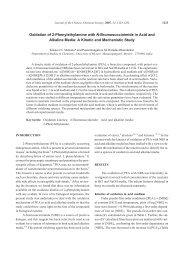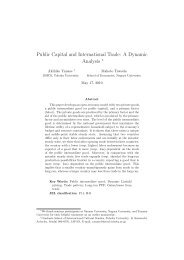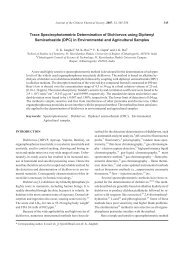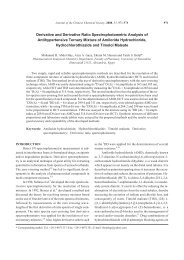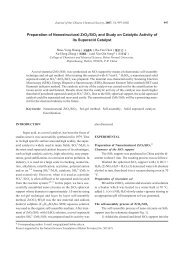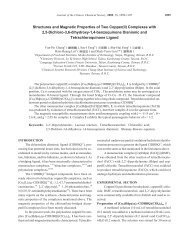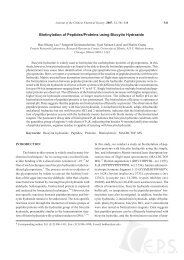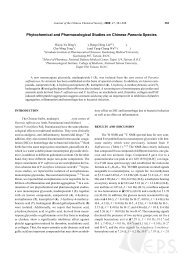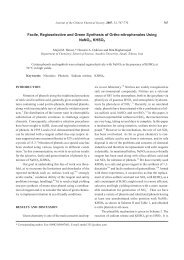Preparation of Silica Supported Tin Chloride: As a Recyclable ...
Preparation of Silica Supported Tin Chloride: As a Recyclable ...
Preparation of Silica Supported Tin Chloride: As a Recyclable ...
Create successful ePaper yourself
Turn your PDF publications into a flip-book with our unique Google optimized e-Paper software.
Note<br />
<strong>Preparation</strong> <strong>of</strong> <strong>Silica</strong> <strong>Supported</strong> <strong>Tin</strong> <strong>Chloride</strong>: <strong>As</strong> a <strong>Recyclable</strong> Catalyst for<br />
the Silylation <strong>of</strong> Hydroxyl Groups with HMDS<br />
Khodabakhsh Niknam, a, * Mohammad Ali Zolfigol, b Dariush Saberi a and Hajar Molaee a<br />
a Department <strong>of</strong> Chemistry, Faculty <strong>of</strong> Sciences, Persian Gulf University, Bushehr 75169, Iran<br />
b Faculty <strong>of</strong> Chemistry, Bu-Ali Sina University, P. O. Box 6517838683, Hamedan, Iran<br />
<strong>Silica</strong>-supported tin chloride [SiO2-Sn(Cl)4-n] has been prepared by mixing tin chloride with activated<br />
silica gel in toluene under refluxing conditions for one day. A range <strong>of</strong> primary, secondary, and tertiary alcohols<br />
as well as phenolic hydroxyl groups were converted into their corresponding trimethylsilyl ethers<br />
with hexamethyldisilazane in the presence <strong>of</strong> catalytic amounts <strong>of</strong> silica-supported tin chloride at room<br />
temperature. An excellent chemoselective silylation <strong>of</strong> hydroxyl groups in the presence <strong>of</strong> other functional<br />
groups was also observed. This catalyst could be recycled and reused fifteen times without loss <strong>of</strong><br />
efficiency.<br />
Keywords: Silylation; <strong>Silica</strong>-supported tin chloride; Hydroxyl groups; Alcohols; Catalyst.<br />
INTRODUCTION<br />
In recent years, the search for environmentally benign<br />
chemical processes or methodologies has received<br />
much attention. 1 Heterogenization <strong>of</strong> homogeneous catalysts<br />
has been an interesting area <strong>of</strong> research from the industrial<br />
point <strong>of</strong> view; this combines the advantages <strong>of</strong> homogeneous<br />
catalysts (high activity and selectivity, etc.)<br />
with the engineering advantages <strong>of</strong> heterogeneous catalysts<br />
(easy catalyst separation, long catalytic life, easy catalyst<br />
regenerability, thermal stability and recyclability). 2<br />
Therefore, attachment <strong>of</strong> Lewis acids on solid supports has<br />
received much attention. One way to convert corrosive,<br />
strong Lewis acids into environmentally friendlier catalysts<br />
is by supporting them on high-surface-area solids,<br />
such as graphite, Al2O3,SiO2, zeolites, clays, etc. The support<br />
has to be thermally and chemically stable during the<br />
reaction process and has to provide accessibility and a good<br />
dispersion <strong>of</strong> the active sites. 2,3<br />
Protection and deprotection <strong>of</strong> functional groups are<br />
inevitable processes for the synthesis <strong>of</strong> poly-functional<br />
compounds. Silylation <strong>of</strong> alcohols and polyols is one <strong>of</strong> the<br />
most commonly used methods for their protection. 4 Trimethylsilylation<br />
is a classic way to produce volatile derivatives<br />
<strong>of</strong> alcohols and polyols, as required for their vapor<br />
phase chromatography/mass spectrometric analysis. 5 Another<br />
application is conversion <strong>of</strong> trimethylsilyl ethers into<br />
Journal <strong>of</strong> the Chinese Chemical Society, 2009, 56, 1257-1264 1257<br />
* Corresponding author. E-mail: niknam@pgu.ac.ir; khniknam@gmail.com<br />
the corresponding dialkyl ethers. 6 Generally, the formation<br />
<strong>of</strong> trimethylsilyl ethers has been carried out by treatment<br />
<strong>of</strong> alcohols with trimethylsilyl chloride or trimethylsilyl<br />
triflate in the presence <strong>of</strong> a base, 7 Li2S, 8 and sometimes a<br />
non-ionic superbase catalyst. 9 However, some <strong>of</strong> these<br />
methods have frequently suffered from drawbacks, such as<br />
lack <strong>of</strong> reactivity or the difficulty in removal <strong>of</strong> amine salts.<br />
1,1,1,3,3,3-Hexamethyldisilazane (HMDS) is a stable,<br />
commercially available, and cheap reagent for trimethylsilylation<br />
<strong>of</strong> hydrogen-labile substrates, 10 giving ammonia<br />
as the only by-product. On the other hand, silylation, using<br />
this silazan-type reagent, is nearly neutral and does not require<br />
any special precautions. However, the weak silylating<br />
ability <strong>of</strong> HMDS is the main drawback for this application<br />
which in many instances needs forceful conditions<br />
and long reaction times. A variety <strong>of</strong> catalysts such as<br />
(CH3)3SiCl, 11 tungstophosphoric acid, 12 H- zeolite, 13<br />
B(C6F5)3, 14 LiClO4, 15 1,3-dibromo-5,5-dimethylhydantoin,<br />
16 silica-supported perchloric acid, 17 tribromomelamine,<br />
18 1,3-dibromo-5,5-diethylbarbituric acid, 19 LaCl3, 20<br />
tribromoisocyanuric acid and DABCO-Br2, 21 vanadium<br />
hydrogen sulfate, 22 Fe(HSO4)3, 23 ZrO(OTf)2, 24 ZnO 25 and<br />
tetrabutylammonium bromide 26 have been reported for the<br />
silylation <strong>of</strong> hydroxyl groups using HMDS. In addition to<br />
the previously reported procedures, the facile and general<br />
synthetic methodology for the silylation <strong>of</strong> alcohols under
1258 J. Chin. Chem. Soc., Vol. 56, No. 6, 2009 Niknam et al.<br />
essentially neutral conditions is in demand, so this encouraged<br />
us to develop an efficient, convenient, and practical<br />
procedure for the protection <strong>of</strong> hydroxyl groups under mild<br />
and heterogeneous conditions.<br />
RESULTS AND DISCUSSION<br />
Along the line <strong>of</strong> our studies in application <strong>of</strong> solid<br />
acid catalysts in chemical transformations, 27,28 herein we<br />
wish to describe the preparation <strong>of</strong> silica-supported tin<br />
chloride as illustrated in Fig. 1, and its use as a catalyst for<br />
the conversion <strong>of</strong> alcohols into the corresponding trimethylsilyl<br />
ethers. <strong>Silica</strong>-supported tin chloride (SiO2-SnCl4-n)<br />
has been prepared by the reaction <strong>of</strong> tin tetrachloride with<br />
activated silica gel which was proved to be a solid acid <strong>of</strong><br />
super acid strength.<br />
The FT-IR spectrum <strong>of</strong> the catalyst (Fig. 2) shows the<br />
absorption range <strong>of</strong> O-Sn asymmetric stretching modes<br />
around 500-550 cm -1 . 29<br />
Powder X-ray diffraction was run and the strongest<br />
peaks <strong>of</strong> the XRD pattern correspond to the SiO2 plane with<br />
the other peaks indexed as the (35), (53), and (67) planes <strong>of</strong><br />
supported tin chloride (Fig. 3).<br />
The trimethylsilylation <strong>of</strong> hydroxyl groups is easily<br />
carried out at room temperature under mild conditions in<br />
Fig. 1. Probable structure <strong>of</strong> covalently anchored silica-supported<br />
tin chloride.<br />
the presence <strong>of</strong> silica-supported Sn(Cl)4-n as catalyst (Scheme<br />
I). First, we tried to convert benzyl alcohol (1 mmol) as a<br />
model reaction, to its corresponding silylether with HMDS<br />
in the presence <strong>of</strong> different catalytic amounts <strong>of</strong> silica-supported<br />
Sn(Cl)4-n (Table 1).<br />
Scheme I Conversion <strong>of</strong> different kinds <strong>of</strong> hydroxyl<br />
groups into corresponding silyl ethers in the<br />
presence <strong>of</strong> silica-supported Sn(Cl)4-n as<br />
catalyst<br />
<strong>As</strong> shown in Table 1, the optimal amount <strong>of</strong> silicasupported<br />
Sn(Cl)4-n was 0.015 g per 1 mmol <strong>of</strong> benzyl alcohol<br />
and 0.8 mmol <strong>of</strong> HMDS.<br />
Also, to optimize the reaction conditions, the model<br />
reaction was employed to screen suitable solvents (Table<br />
2). The results in Table 2 show that amongst these solvents,<br />
acetonitrile was the solvent <strong>of</strong> choice in terms <strong>of</strong> reaction<br />
time and product yield.<br />
Next, we prepared a range <strong>of</strong> silylethers under the following<br />
reaction conditions: hydroxyl compound (1 mmol),<br />
HMDS (0.8 mmol), silica-supported Sn(Cl)4-n (0.015 g),<br />
and acetonitrile (2 mL) (Table 3). A wide range <strong>of</strong> various<br />
alcohols underwent silylation by this procedure to provide<br />
the corresponding TMS ethers in good to excellent yields.<br />
Benzylic, primary and secondary alcohols, and also phenols<br />
generally react faster than tertiary alcohols. Trimethyl-<br />
Fig. 2. FT-IR spectra <strong>of</strong> silica-supported Sn(Cl)4-n. Fig. 3. XRD <strong>of</strong> silica-supported Sn(Cl)4-n.
Silylation <strong>of</strong> Hydroxyl Groups J. Chin. Chem. Soc., Vol. 56, No. 6, 2009 1259<br />
Table 1. Silylation <strong>of</strong> benzyl alcohols with HMDS in the<br />
presence <strong>of</strong> different catalytic amounts <strong>of</strong> silicasupported<br />
Sn(Cl) 4-n in acetonitrile at room temperature a<br />
Entry<br />
The amounts <strong>of</strong><br />
catalyst (g)<br />
Time<br />
(min)<br />
Conversion<br />
(%)<br />
1 0.005 60 050<br />
2 0.010 30 090<br />
3 0.015 05 100<br />
4 0.030 05 100<br />
a<br />
The molar ratios <strong>of</strong> substrate: HMDS were used as follows 1:<br />
0.8 mmol respectively.<br />
Table 2. Silylation <strong>of</strong> benzyl alcohols with HMDS in the<br />
presence <strong>of</strong> silica-supported Sn(Cl) 4-n as catalyst at<br />
room temperature in different solvents a<br />
Entry Solvent b<br />
Time (min) Conversion (%)<br />
1 n-Hexane 300 80<br />
2 Dichloromethane 300 90<br />
3 Chlor<strong>of</strong>orm 300 25<br />
4 Ethyl acetate 100 82<br />
5 Diethyl ether 300 68<br />
6 Acetonitrile 005 1000<br />
7 Acetone 300 75<br />
a<br />
The molar ratios <strong>of</strong> substrate: HMDS: Cat. were used as follows<br />
1: 0.8: mmol and 0.015 g, respectively.<br />
b<br />
The amount <strong>of</strong> solvent chosen was 2 mL.<br />
silylation <strong>of</strong> hydroxyl groups produce corresponding trimethylsilylated<br />
compounds under these conditions, whereas<br />
substituted thiophenol, 1-butantiol (Table 3, entries 17,<br />
and 29, 30), aniline and aliphatic amines derivatives (Table<br />
3, entries 26-28) and N-phenyl acetamide (Table 3, entry<br />
31) remained intact under the reaction conditions. Allylic<br />
and propargylic alcohols such as cinnamyl, allyl and propargyl<br />
alcohols converted to unidentified polymeric material<br />
under these conditions (Table 3, entry 25-27). 12 It is<br />
worth mentioning that in the case <strong>of</strong> p-aminophenol only<br />
the phenolic group reacted under these conditions and the<br />
amino group remains intact (Table 3, entry 6).<br />
We investigated selective silylation <strong>of</strong> mixtures <strong>of</strong> alcohols<br />
in the presence <strong>of</strong> amine, amide, and thiol functionalities.<br />
This method was shown to be highly selective for<br />
the primary alcohols such as benzyl alcohol and 2-phenylethanol.<br />
The primary alcohols were completely converted<br />
to the corresponding silyl ethers, while tertiary alcohols<br />
were untouched (Scheme II, Table 3, entries 6 and 17). Excellent<br />
chemoselectivity was also observed for the conversion<br />
<strong>of</strong> secondary alcohols and phenols in the presence <strong>of</strong><br />
Scheme II Chemoselectivity between primary, secondary<br />
alcohols and phenols in the presence<br />
<strong>of</strong> tertiary alcohols and amides using<br />
silica-supported Sn(Cl)4-n with HMDS<br />
tertiary alcohols such as -terpinene, 1-phenyl-2-methyl-<br />
2-propanol.<br />
We also explored the chemoselectivity <strong>of</strong> silica-supported<br />
Sn(Cl)4-n in the silylation method. Alcohols and<br />
phenols in the presence <strong>of</strong> an amine, amide and thiols were<br />
completely converted to the corresponding trimethylsilyl<br />
ethers as the sole product.<br />
To show the efficiency <strong>of</strong> the silica-supported Sn(Cl)4-n<br />
in comparison with some previously reported procedures,<br />
Table 4 compares some <strong>of</strong> our results with H- zeolite, 13<br />
LiClO4-SiO2, 15 LaCl3, 20 Fe(HSO4)3, 23 ZrO(OTf)2, 24 and<br />
ZnO 25 with respect to reaction times and yields.<br />
In all the reactions we have studied, fast evolution <strong>of</strong><br />
ammonia gas was observed. With this observation we have<br />
proposed a mechanism in which the generation <strong>of</strong> NH3 and<br />
the role <strong>of</strong> silica-supported Sn(Cl)4-n in a catalytic cycle is<br />
clarified (Scheme III). 17,22
1260 J. Chin. Chem. Soc., Vol. 56, No. 6, 2009 Niknam et al.
Silylation <strong>of</strong> Hydroxyl Groups J. Chin. Chem. Soc., Vol. 56, No. 6, 2009 1261
1262 J. Chin. Chem. Soc., Vol. 56, No. 6, 2009 Niknam et al.<br />
Scheme III Proposed mechanism for the conversion<br />
<strong>of</strong> alcohols into corresponding silyl ether<br />
by using silica-supported Sn(Cl)4-n<br />
The possibility <strong>of</strong> recycling the catalyst was examined.<br />
For this reason, the reaction <strong>of</strong> benzyl alcohol and<br />
HMDS was studied in acetonitrile at room temperature in<br />
the presence <strong>of</strong> silica-supported Sn(Cl)4-n. When the reaction<br />
was complete, the mixture was filtered and the catalyst<br />
was washed with dichloromethane and reused. The recy-<br />
cled catalyst could be reused fifteen times without any<br />
treatment. No observation <strong>of</strong> appreciable loss in its catalytic<br />
activities was shown (Fig. 4).<br />
Fig. 4. Recyclability <strong>of</strong> silica-supported Sn(Cl)4-n<br />
(0.015 g) as catalyst in the silylation reaction <strong>of</strong><br />
benzyl alcohol (1 mmol) and HMDS (1 mmol)<br />
at room temperature. Reaction time = 5 min.
Silylation <strong>of</strong> Hydroxyl Groups J. Chin. Chem. Soc., Vol. 56, No. 6, 2009 1263<br />
CONCLUSION<br />
In conclusion, a practical, efficient and convenient<br />
method for the silylation <strong>of</strong> hydroxyl compounds was described.<br />
Also, we prepared and introduced SnCl4 supported<br />
on silica gel as an efficient and reusable catalyst. Therefore,<br />
we think that this method can be a useful addition to<br />
the present methodologies for the silylation <strong>of</strong> hydroxyl<br />
groups.<br />
EXPERIMENTAL SECTION<br />
General<br />
Chemicals were purchased from Merck, Fluka and<br />
Aldrich Chemical Companies. IR spectra were run on a<br />
Shimadzu Infra Red Spectroscopy FT-IR-8000. The 1 H<br />
NMR were run on a JEOL NMR-Spectrometer FX 90Q and<br />
a Bruker Avance (DRX 500 MHz). Melting points were recorded<br />
on a Melting Point SMP1 apparatus in open capillary<br />
tubes and are uncorrected. With TLC using silica gel<br />
SILG/UV 254 plates the progress <strong>of</strong> reaction was followed.<br />
All <strong>of</strong> the products are known and characterized by comparison<br />
<strong>of</strong> their spectral (IR, 1 H-NMR), TLC and physical<br />
data with those reported in the literature. 14-22<br />
Catalyst preparation<br />
<strong>Silica</strong> gel 60 (0.063-0.200 mesh) was washed with 1<br />
M HCl, followed by deionized water, 30% H2O2, and deionized<br />
water again. After being washed, the silica was<br />
dried overnight at 373 K in vacuum to give preconditioned<br />
silica gel. 2<br />
<strong>Preparation</strong> <strong>of</strong> silica-supported tin chloride<br />
4.0 g <strong>of</strong> preconditioned silica was first refluxed in toluene<br />
for 2 h. Then tin chloride (5.5 mL) was added to this<br />
mixture and allowed to react for 1 day under refluxing condition.<br />
Then, the mixture was filtered and washed three<br />
times with absolute ethanol and dried at 373 K to give<br />
5.137 g <strong>of</strong> product (0.2 g equal to 0.6 mmol H + ).<br />
FT-IR spectrum <strong>of</strong> silica-supported tin chloride<br />
The FT-IR spectrum <strong>of</strong> the catalyst is shown in Fig. 2.<br />
The catalyst is solid, and its solid state IR spectrum was recorded<br />
using the KBr disk technique. For silica (SiO2), the<br />
major peaks are broad antisymmetric Si-O-Si stretching<br />
from 1200 to 1000 cm -1 and symmetric Si-O-Si stretching<br />
near 802 cm -1 , and bending modes <strong>of</strong> Si-O-Si lie around<br />
470 cm -1 . For the O-Sn-Cl group, the FT-IR absorption<br />
range <strong>of</strong> the O-Sn asymmetric stretching modes lies around<br />
500-550 cm -1 . 29 The spectrum also shows a broad Si-OH<br />
stretching absorption from 3600-3000 cm -1 .<br />
X-ray diffraction (XRD) <strong>of</strong> silica-supported tin chloride<br />
Powder X-ray diffraction measurement was performed<br />
using a D8 Advance Diffractometer made by Bruker AXS<br />
Company in Germany. The strongest peaks <strong>of</strong> the XRD pattern<br />
correspond to the SiO2 plane with the other peaks indexed<br />
as the (35), (53), and (67) planes <strong>of</strong> supported tin<br />
chloride.<br />
General procedure<br />
To a stirred solution containing the hydroxyl compound<br />
(1 mmol) and HMDS (0.8 mmol) in CH3CN (2 mL)<br />
was added silica supported Sn(Cl)4-n (0.015 g) and stirred<br />
at room temperature. When the reaction was complete GC<br />
(or TLC, n-hexane-EtOAc, 9:1) analysis, CH2Cl2 was added<br />
(10 mL), and silica supported Sn(Cl)4-n was removed by filtration.<br />
The solvent was evaporated and the trimethylsilyl<br />
ether was isolated almost as a pure product. Further purification<br />
was carried out by short column chromatography on<br />
silica gel eluting with ethyl acetate/petroleum ether, if necessary.<br />
ACKNOWLEDGEMENT<br />
We are thankful to the Persian Gulf University Research<br />
Council for partial support <strong>of</strong> this work.<br />
Received March 6, 2009.<br />
REFERENCES<br />
1. Choudhary, D.; Paul, S.; Gupta, R.; Clark, J. H. Green<br />
Chem. 2006, 8, 479-482.<br />
2. Li, Z.; Ma, X.; Liu, J.; Feng, X.; Tian, G.; Zhu, A. J. Mol.<br />
Catal. A Chem. 2007, 272, 132.<br />
3. Jyothi, T. M.; Kaliya, M. L.; Herskowitz, M.; Landau, M. V.<br />
Chem. Commun. 2001, 992.<br />
4. Greene, T. W.; Wutes, P. G. M. Greene’s Protective Groups<br />
in Organic Synthesis,4 th ed.; Wiley: New York, 2007.<br />
5. Van Look, G.; Simchen, G.; Heberle, J. Silylating Agents,2 nd<br />
ed.; Fluka, Buches: Switzerland, 1995.<br />
6. Zolfigol, M.-A.; Mohammadpoor-Baltork, I.; Habibi, D.;<br />
Mirjalili, B.-F.; Bamoniri, A. Tetrahedron Lett. 2003, 44,<br />
8165.<br />
7. Corey, E. J.; Sinder, B. B. J. Am. Chem. Soc. 1972, 94, 2549.<br />
8. Olah, G. A.; Gupta, B. G. B.; Narang, S. C.; Malhotra, R. J.<br />
Org. Chem. 1979, 44, 4272.<br />
9. Sa,B.A.D.;McLeod,D.;Verkade,J.G. J. Org. Chem. 1997,<br />
62, 5057.<br />
10. Lalonde, M.; Chan, T. H. Synthesis 1985, 817.<br />
11. Gauttret, P.; El-Ghamarti, S.; Legrand, A.; Coutrier, D.;<br />
Rigo, B. Synth. Commun. 1996, 26, 707.
1264 J. Chin. Chem. Soc., Vol. 56, No. 6, 2009 Niknam et al.<br />
12. Firouzabadi, H.; Iranpoor, N.; Amani, K.; Nowrouzi, F. J.<br />
Chem. Soc. Perkin Trans 1 2002, 2601.<br />
13. Tillu, V. H.; Jadhav, V. H.; Borate, H. B.; Wakharkar, R. D.<br />
Arkivoc 2004, 14, 83.<br />
14. Shinke, S.; Tsuchimoto, T.; Kawakami, Y. Silicon Chem.<br />
2005, 3, 243.<br />
15. Azizi, N.; Yousefi, R.; Saidi, M. R. J. Organomet. Chem.<br />
2006, 691, 817.<br />
16. Khazaei, A.; Rostami, A.; Mahboubifar, M. J. Chin. Chem.<br />
Soc. 2007, 54, 483-487.<br />
17. Shaterian, H. R.; Shahrekipoor, F.; Ghashang, M. J. Mol.<br />
Catal. A Chem. 2007, 272, 142.<br />
18. Ghorbani-Choghamarani, A.; Zolfigol, M. A.; Hajjami, M.;<br />
Jafari, S. J. Chin. Chem. Soc. 2008, 55, 1208-1213.<br />
19. Khazaei, A.; Zolfigol, M. A.; Tanbakouchian, Z.; Shiri, M.;<br />
Niknam, K.; Saien, J. Catal. Commun. 2007, 8, 917.<br />
20. Narsaiah, A. V. J. Organomet. Chem. 2007, 692, 3614.<br />
21. Niknam, K.; Zolfigol, M. A.; Chehardoli, G.; Dehghanian,<br />
M. Chin.J.Catal. 2008, 29, 901.<br />
22. Shirini, F.; Zolfigol, M. A.; Abedini, M.; Sakhaei, A. R. J.<br />
Chin. Chem. Soc. 2008, 55, 943-946.<br />
23. Shirini, F.; Zolfigol, M. A.; Abri, A. Monatsh. Chem. 2008,<br />
139, 17.<br />
24. Moghadam, M.; Tangestaninejad, S.; Mirkhani, V.;<br />
Mohammadpoor-Baltork, I.; Chahardahcheric, S.; Tavakoli,<br />
Z. J. Organomet. Chem. 2008, 693, 2041.<br />
25. Shaterian, H. R.; Ghashang, M. Phosphorus, Sulfur Silicon<br />
Relat. Elem. 2008, 183, 194.<br />
26. Shirini, F.; Abedini, M. J. Iran. Chem. Soc. 2008, 5, S87.<br />
27. (a) Zolfigol, M.-A.; Niknam, K.; Nazari, F. J. Chin. Chem.<br />
Soc. 2006, 53, 669-676. (b) Zolfigol, M.-A.; Bagherzadeh,<br />
M.; Niknam, K.; Shirini, F.; Mohammadpoor-Baltork, I.;<br />
Choghamarani, A.-G.; Baghbanzadeh, M. J. Iran. Chem.<br />
Soc. 2006, 3, 73-80. (c) Niknam, K.; Zolfigol, M.-A.;<br />
Khoramabadi-Zad, A.; Zare, R.; Shayegh, M. Catal.<br />
Commun. 2006, 7, 494-498. (d) Zolfigol, M.-A.; Niknam,<br />
K.; Bagherzadeh, M.; Choghamarani, A.-G.; Koukabi, N.;<br />
Hajjami, M.; Kolvari, E. J. Chin. Chem. Soc. 2007, 54, 1115-<br />
1118. (e) Niknam, K.; Fatehi-Raviz, A. J. Iran. Chem. Soc.<br />
2007, 4, 438-443. (f) Zolfigol, M. A.; Ghaemi, E.; Madrakian,<br />
E.; Niknam, K. J. Chin. Chem. Soc. 2008, 55, 704-711. (g)<br />
Zolfigol, M. A.; Chehardoli, G.; Dehghanian, M.; Niknam,<br />
K.; Shirini, F.; Khoramabadi-Zad, A. J. Chin. Chem. Soc.<br />
2008, 55, 885-889.<br />
28. (a) Niknam, K.; Zolfigol, M.-A.; Sadabadi, T.; Nejati, A. J.<br />
Iran. Chem. Soc. 2006, 3, 318-322. (b) Niknam, K.; Zolfigol,<br />
M.-A.; Shayegh, M.; Zare, R. J. Chin. Chem. Soc. 2007, 54,<br />
1067-1073. (c) Niknam, K.; Zolfigol, M.-A.; Sadabadi, T. J.<br />
Iran. Chem. Soc. 2007, 4, 199-204. (d) Niknam, K.; Zolfigol,<br />
M.-A.; Tavakoli, Z.; Heidari, Z. J. Chin. Chem. Soc. 2008,<br />
55, 1373-1378.<br />
29. Kawakami, K.; Okawara, R. J. Organomet. Chem. 1966, 6,<br />
249.



